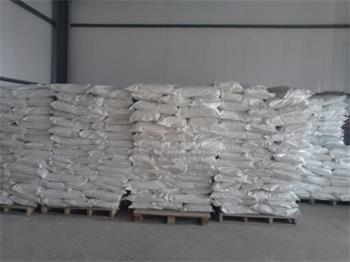顺酐是顺丁烯二酸酐的简称,又称马来酸酐或者失水苹果酸酐,是一种重要的有机化工原料或精细化学品,主要用于不饱和聚酯树脂、醇酸树脂、1,4-丁二醇(BDO)、四氢苯酐等化工产品,开发应用前景十分广阔。目前国内外在正丁烷为原料的顺酐工艺中,多采用有机溶剂为吸收剂,有机溶剂一般为六氢化邻苯二甲酸二异丁酯(DIBE)和邻苯二甲酸二丁酯(DBP)。有机溶剂吸收顺酐后通过气提工段提纯顺酐,吸收剂经分离机处理之后循环使用。以正丁烷为原料顺酐产生的废水来源于三部分,即解析真空泵排出的废水、精制真空泵排出的废水和离心机轻相排出的废水,其中混合有机酸及醋成分包括丙烯酸、马来酸、富马酸、邻苯二甲酸、六氢化邻苯二甲酸二异丁酯(DIBE)或者邻苯二甲酸二丁醋(DBP) 、丙烯酸二聚体,废水pH=0.5-1.5,总有机物含量在1.0%-1.4% ,几乎不含氮、磷和无机盐类,属于高浓度化工废水。有机酸及DIBE等溶剂是增加水体COD的源头,还含有一定量的氨(胺)基化合物、杂环化合物、酚类、苯类,属生物不易降解高浓度有机废水成分,对微生物生长具有抑制作用。此类废水中间产物均对微生物有较强的抑制作用,我们常称为生物毒性,并具有很强的腐蚀性。
Maleic anhydride, also known as maleic anhydride or dehydrated malic anhydride, is an important organic chemical raw material or fine chemical used in the production of unsaturated polyester resin, alkyd resin, 1,4-butanediol (BDO), tetrahydrophthalic anhydride and other chemical products. Its development and application prospects are very broad. At present, in the production process of maleic anhydride using n-butane as raw material both domestically and internationally, organic solvents are mostly used as absorbers. The organic solvents are generally diisobutyl hexahydrophthalate (DIBE) and dibutyl phthalate (DBP). After the organic solvent absorbs maleic anhydride, it is purified through the gas extraction section, and the absorbent is treated by a separator before recycling. The wastewater generated from the production of maleic anhydride using n-butane as raw material comes from three parts, namely the wastewater discharged from the analytical vacuum pump, the wastewater discharged from the refining vacuum pump, and the wastewater discharged from the centrifuge light phase. The mixed organic acid and vinegar components include acrylic acid, maleic acid, fumaric acid, phthalic acid, diisobutyl hexahydrophthalate (DIBE) or dibutyl phthalate (DBP), and acrylic acid dimer, with a pH of 0.5-1.5, The total organic matter content is between 1.0% -1.4%, almost free of nitrogen, phosphorus, and inorganic salts, belonging to high concentration chemical wastewater. Organic acids and solvents such as DIBE are the sources of increasing COD in water bodies. They also contain a certain amount of ammonia (amine) based compounds, heterocyclic compounds, phenols, and benzenes, which are not easily degraded by organisms as high concentration organic wastewater components and have inhibitory effects on microbial growth. The intermediate products of this type of wastewater have a strong inhibitory effect on microorganisms, commonly referred to as biological toxicity, and have strong corrosiveness.
目前的顺酐废水处理工艺一般是:顺酐工艺废水-集水井-隔油调节池-EBR反应器(铁碳微电解)-破乳反应池-气浮系统-缓冲水池-混凝沉淀池-配水池-IC反应器-一阶氧化-中间沉淀池-二阶氧化池-二级沉淀池-臭氧氧化池-生物滤池-清水池,由于其中含有较多的难降解有机物,经过现有技术进行生物降解后仍很难达到排放标准,并且造成废水处理费用高。

The current treatment processes for maleic anhydride wastewater generally include: maleic anhydride process wastewater - collection well - oil separation regulation tank - EBR reactor (iron carbon micro electrolysis) - demulsification reaction tank - air flotation system - buffer tank - coagulation sedimentation tank - distribution tank - IC reactor - first order oxidation - intermediate sedimentation tank - second order oxidation tank - second order sedimentation tank - ozone oxidation tank - biofilter - clean water tank. Due to the high content of difficult to degrade organic matter, After biodegradation with existing technologies, it is still difficult to meet the discharge standards and result in high wastewater treatment costs.
现有技术中处理顺酐废水时,把顺酐废水中的马来酸异构为富马酸,然后降温结晶得到富马酸,同时降低废水中有机物含量,但是此方法仅适用于水吸收法顺酐工艺,而不适用普遍使用的有机溶剂吸收法。
In the existing technology, when treating maleic anhydride wastewater, the maleic acid in the wastewater is isomerized into fumaric acid, which is then cooled and crystallized to obtain fumaric acid, while reducing the organic content in the wastewater. However, this method is only applicable to the water absorption method of maleic anhydride process, and is not applicable to the commonly used organic solvent absorption method.
另外,有人提出一种顺酐废水处理的新工艺,即使用碱性萃取剂回收其中的马来酸和富马酸,降低废水中的有机物,然后再去生化处理废水,但是废水中六氢化邻苯二甲酸二异丁酯(DIBE)或者邻苯二甲酸二丁醋(DBP)的可生化降解性比富马酸、马来酸等要低很多,其主要是针对废水中的有机酸性物质的回收处理,但该方法对于废水中的难降解有机物如DIBE或者DBP没有考虑,废水难降解有机物含量依然较高,亦难以进行生化处理,主要依靠其他水稀释处理达标排放。可见,顺酐废水处理工艺需要进行改进。
In addition, some people have proposed a new process for treating maleic anhydride wastewater, which uses alkaline extractants to recover maleic acid and fumaric acid, reduce organic matter in the wastewater, and then biochemical treatment of the wastewater. However, the biodegradability of diisobutyl hexahydrophthalate (DIBE) or dibutyl phthalate vinegar (DBP) in the wastewater is much lower than that of fumaric acid, maleic acid, etc, It mainly focuses on the recovery and treatment of organic acidic substances in wastewater, but this method does not consider the difficult to degrade organic substances such as DIBE or DBP in wastewater. The content of difficult to degrade organic substances in wastewater is still high, and it is also difficult to carry out biochemical treatment. It mainly relies on other water dilution treatments to meet the discharge standards. It can be seen that the treatment process of maleic anhydride wastewater needs to be improved.




